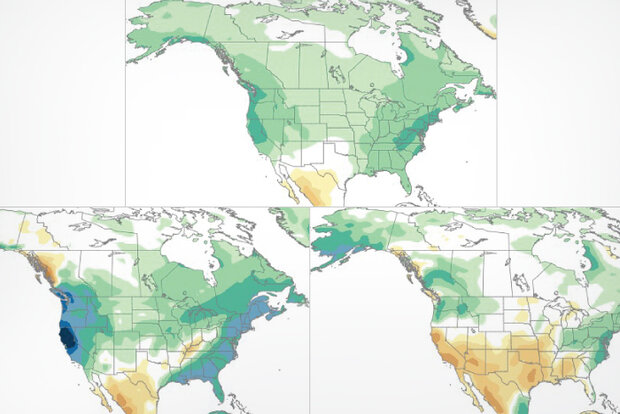Blogs
Happy new year! This La Niña event is likely near peak strength as we start 2022. Related impacts to global weather and climate will continue through the rest of winter and into the spring, however, because climate impacts lag tropical Pacific sea surface temperature changes. Forecasters favor a transition to neutral in the April–June period.
Chutes and Ladders
The sea surface temperature in the Niño-3.4 region of the tropical Pacific—our primary measurement of the El Niño/Southern Oscillation (ENSO) system—was 1.1° C cooler than the 1991–2020 average in December, via the ERSSTv5 observation dataset.
The three-month temperature deviation from average in Niño-3.4, the Oceanic Niñ…
Read article
La Niña continues as the Northern Hemisphere heads into winter, and forecasters are confident that it will hang around through the rest of the winter. This La Niña, the second in two years, will likely transition to ENSO-neutral sometime in the spring. There’s about a 60% chance the late spring and summer will feature neutral conditions.
Magnifying glass
Time for a closer look at the tropical Pacific, the home of the El Niño-Southern Oscillation climate pattern!
La Niña’s hallmark cooler-than-average ocean surface is readily apparent across much of the tropical Pacific. Over the past few weeks, cool anomalies have increased in the eastern Pacific, and in general we see a well-es…
Read article
Mike Halpert has guest blogged for us each fall, and because this is his last guest blog before retirement in later 2022, we want to briefly highlight his contributions. He has worked at NOAA Climate Prediction Center for 41 years and has served as Deputy Director for the last 15 years. He has patiently answered oodles and oodles of questions about climate outlooks, starred in many of Climate.gov's video outlooks, served on the Climate.gov science advisory panel, and acted as a moderator moderator on the blog since inception in 2014. Mike is famous to us because he played a critical role in discovering and documenting climate impacts associated with El Niño and La Niña in a set of very highl…
Read article
La Niña conditions reign in the tropical Pacific, with about a 90% chance of remaining through the winter. Get your popcorn and settle down on the couch—it’s time for this month’s ENSO cinema.
Romantic comedy
A recurring theme here at the ENSO Blog is the on-again, off-again relationship between the tropical Pacific Ocean and atmosphere. ENSO (short for El Niño-Southern Oscillation, the entire El Niño–La Niña system) relies on the interaction between the ocean and the atmosphere. Average conditions in the tropical Pacific (see the drawing below) consist of relatively warmer surface water in the west and relatively cooler surface in the east. Air rises over the warm western water, formi…
Read article
When the climate doesn’t behave like we expect, whether it’s for an individual season or for several decades, we often hear scientists blaming internal variability. Scientists use this term a lot (even on Twitter) and I’ve noticed that I usually obtain a few blank faces depending on the audience. I also remember being a junior scientist in this field and wondering why everyone was going on about internal, or its counterpart, external variability. Internal/External what? And who cares? Me! And you should, too!
In our climate and weather there are:
(1) The things that are pushed around by other (external) things
(2) The things that would change or move (internally) without any pus…
Read article




